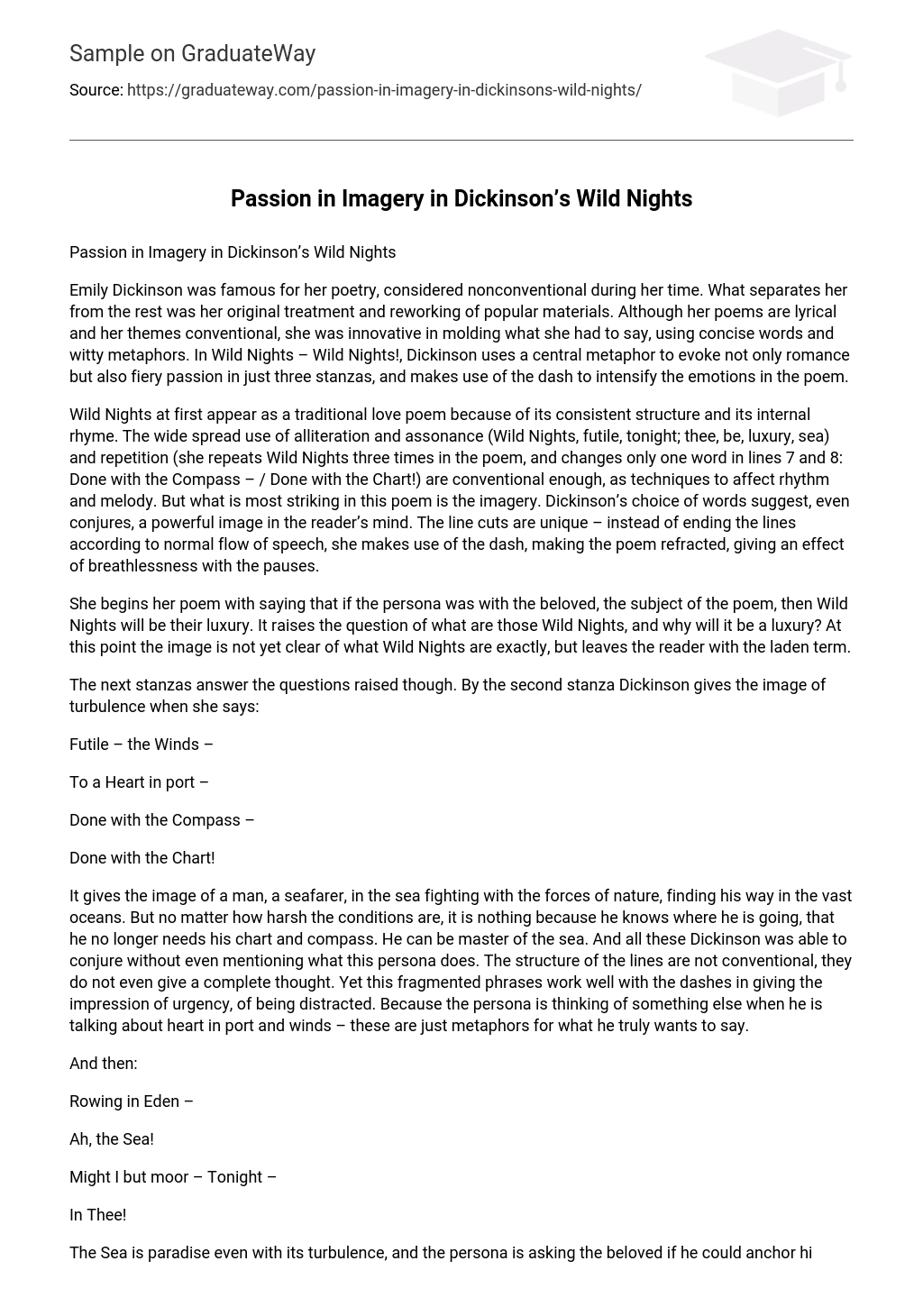Emily Dickinson was famous for her poetry, considered nonconventional during her time. What separates her from the rest was her original treatment and reworking of popular materials. Although her poems are lyrical and her themes conventional, she was innovative in molding what she had to say, using concise words and witty metaphors. In Wild Nights – Wild Nights!, Dickinson uses a central metaphor to evoke not only romance but also fiery passion in just three stanzas, and makes use of the dash to intensify the emotions in the poem.
Wild Nights at first appear as a traditional love poem because of its consistent structure and its internal rhyme. The wide spread use of alliteration and assonance (Wild Nights, futile, tonight; thee, be, luxury, sea) and repetition (she repeats Wild Nights three times in the poem, and changes only one word in lines 7 and 8: Done with the Compass – / Done with the Chart!) are conventional enough, as techniques to affect rhythm and melody. But what is most striking in this poem is the imagery. Dickinson’s choice of words suggest, even conjures, a powerful image in the reader’s mind. The line cuts are unique – instead of ending the lines according to normal flow of speech, she makes use of the dash, making the poem refracted, giving an effect of breathlessness with the pauses.
She begins her poem with saying that if the persona was with the beloved, the subject of the poem, then Wild Nights will be their luxury. It raises the question of what are those Wild Nights, and why will it be a luxury? At this point the image is not yet clear of what Wild Nights are exactly, but leaves the reader with the laden term.
The next stanzas answer the questions raised though. By the second stanza Dickinson gives the image of turbulence when she says:
Futile – the Winds –
To a Heart in port –
Done with the Compass –
Done with the Chart!
It gives the image of a man, a seafarer, in the sea fighting with the forces of nature, finding his way in the vast oceans. But no matter how harsh the conditions are, it is nothing because he knows where he is going, that he no longer needs his chart and compass. He can be master of the sea. And all these Dickinson was able to conjure without even mentioning what this persona does. The structure of the lines are not conventional, they do not even give a complete thought. Yet this fragmented phrases work well with the dashes in giving the impression of urgency, of being distracted. Because the persona is thinking of something else when he is talking about heart in port and winds – these are just metaphors for what he truly wants to say.
And then:
Rowing in Eden –
Ah, the Sea!
Might I but moor – Tonight –
In Thee!
The Sea is paradise even with its turbulence, and the persona is asking the beloved if he could anchor his ship in the subject, the beloved. Dickinson subtly juxtaposed the image of the sea with the beloved’s body, the woman’s body as the Eden, the paradise that is navigated. The reader deduces the beloved must be woman because of the persona’s ship that has to be moored. The ship, which is not even mentioned but left to the imagination, is the unspoken phallic symbol, the mooring the sexual act. Hence the reader understands what these Wild Nights mean: a voyage through the tumultuous waters to find Eden. By using the image of a seafarer Dickinson has successfully gave image to passion, that of man navigating his way through the heated passions culminating to his final destination, climax, that which is paradise. And this is guided by passion not by calculation as the persona was done with the charts and compass.
Wild Nights exhibits not only Dickinson’s prowess and mastery of the lyric, but also her daring. This was written during a time of fixed forms and rhymes, of social norms and tradition, yet showed that no subject can ever be taboo, that words can tame ideas no matter how fiery they can be. She turned a love poem into a fearless, passionate endeavor, not merely a coy expression or declaration. Wild Nights captured the heat and fire that comes with love. For love is not merely romance – it is also about desire, pure raging emotions, passion. And because of this unconventional treatment of a conventional theme, of deftly using an image to bring to the fore the unsaid (and perhaps at the time unthinkable) and soliciting strong emotions, re-creating the fragmented speech and act through the form, Wild Nights is a love poem that may not be modern in the sense of being free verse, but it helped paved the way for the rules to be bent and dispensed with its unconventional style.
SOURCE:
Dickinson, Emily. “Wild Nights – Wild Nights!” The Bedford Introduction to Literature. Ed. Michael Meyer, 4th ed. Boston: Bedford-St. Martin’s. 1996.





